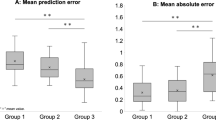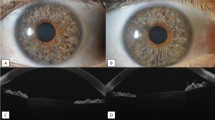Abstract
Purpose
To investigate the significance of the anterior ciliary vessels (ACVs) preservation during the conventional horizontal strabismus surgery.
Methods
Patients (≥ 8 years) with horizontal strabismus were randomly allocated into group 1 (with ACV preservation) and group 2 (without ACV preservation). The surgical eyes in group 1 were further divided into group A (one rectus muscle operated) and group B (two rectus muscles operated). Similarly, eyes in group 2 were divided into group C (one rectus muscle operated) and group D (two rectus muscles operated). The success rate of ACV preservation was calculated. The anterior chamber flare measurements of each eye by laser flare photometry were recorded on the day prior to and after operation. The flare values between groups and between pre- and post-operation in each group were compared by one-way analysis of variance and a paired t-test respectively.
Results
In groups A and B, the success rate of ACV preservation was 82% (27/33) and 70% (28/40)respectively, and the flare values between pre- and post-operation showed no significant differences(4.378 ± 1.527, 4.544 ± 1.452, P = 0.526; 4.625 ± 1.090, 4.989 ± 1.468, P = 0.101 respectively). However, the postoperative values were significantly increased in group C and group D(4.661 ± 1.031, 5.039 ± 1.310, P = 0.025; 4.933 ± 1.691, 5.502 ± 1.430, P = 0.000 respectively). The postoperative flare readings of group D were significantly higher than group B, while group A and group C had no significant variation.
Conclusion
ACV preservation probably has clinical significance in reducing the undesirable influence on the blood–aqueous barrier.




Similar content being viewed by others
References
Wilcox LM, Keough EM, Connally RJ, Hotte CE (1980) The contribution of blood flow by the anterior ciliary arteries to the anterior segment in the primate eye. Exp Eye Res 30(2):167–174
Wright KW, Lanier AB (1991) Effect of a modified rectus tuck on anterior segment circulation in monkeys. J Pediatr Ophthalmol Strabismus 28(2):77–81
Simon JW, Grajny A (2004) Anterior segment ischemia following augmented 2-muscle transposition surgery. J AAPOS 8(6):586–587
Simon JW, Price EC, Krohel GB, Poulin RW, Reinecke RD (1984) Anterior segment ischemia following strabismus surgery. J Pediatr Ophthalmol Strabismus 21(5):179–185
Saunders RA, Phillips MS (1988) Anterior segment ischemia after three rectus muscle surgery. Ophthalmology 9(4):533–537
McKeown CA, Lambert HM, Shore JW (1989) Preservation of the anterior ciliary vessels during extraocular muscle surgery. Ophthalmology 96(4):498–506
Wakefield D, Herbort CP, Tugal-Tutkun I, Zierhut M (2010) Controversies in ocular inflammation and immunology laser flare photometry. Ocular Immunology & Inflammation 18(5):334–340. https://doi.org/10.3109/09273948.2010.512994
Sawa M (2011) Development of non-invasive clinical examination methods for the anterior segment of the eye and their clinical significance. Nippon Ganka Gakkai Zasshi1 15(3):177–211
Tugal-Tutkun I, Herbort CP (2010) Laser flare photometry: a noninvasive, objective, and quantitative method to measure intraocular inflammation. Int Ophthalmol 30(5):453–464. https://doi.org/10.1007/s10792-009-9310-2
Aguirre Vila-Coro A (1990) Vascular microdissection in strabismus surgery. Arch Ophthalmol 108(10):1034–1036
Chen MS, Chang CC, Ho TC, Tsai TH, Fan IM, Hou PK (2010) Blood–aqueous barrier function in a patient with choroideremia. J Formos Med Assoc 109(2):167–171. https://doi.org/10.1016/S0929-6646 (10) 60038-1
Yasuda K, Motohashi R, Kotake O, Nakagawa H, Noma H, Shimura M (2016) Comparative effects of topical diclofenac and betamethasone on inflammation after vitrectomy and cataract surgery in various vitreoretinal diseases. J Ocul Pharmacol Ther 32(10):677–684. https://doi.org/10.1089/jop.2016.0099
Demirel S, Bilici S, Batıoğlu F, Özmert E (2016) Is there any difference between ranibizumab and aflibercept injections in terms of inflammation measured with anterior chamber flare levels in age-related macular degeneration patients: a comparative study. Ophthalmic Res 56(1):35–40. https://doi.org/10.1159/000444497[PubMed:27027523]
Mulder VC, Tode J, van Dijk EH, Purtskhvanidze K, Roider J, van Meurs JC, Treumer F (2017). Preoperative aqueous humour flare values do not predict proliferative vitreoretinopathy in patients with rhegmatogenous retinal detachment. Br J Ophthalmol 2017 Jan 11. Pii: bjophthalmol-2016-309134. https://doi.org/10.1136/bjophthalmol-2016-309134
Johnson MS, Christiansen SP, Rath PP, Watanabe TM, Merten G, Bothun ED, Anderson JS (2009) Anterior ciliary circulation from the horizontal rectus muscles. Strabismus 17(1):45–48. https://doi.org/10.1080/09273970802678180
Akyüz Unsal AI, Unsal A, Ozkan SB, Karaman CZ (2007) The effect of strabismus surgery on retrobulbar hemodynamics. J AAPOS 11(3):277–281. https://doi.org/10.1016/j.jaapos.2006.12.059
Funding
The Department of Science and Technology of Fujian province provided financial support in the form of the Science and Technology Project of Fujian Province (Grant No. 2016D007, Website: http://xmgl.fjkjt.gov.cn/p_itemsearch.pr.pr_itemsearch.do#), China.
The sponsor had no role in the design or conduct of this research.
Author information
Authors and Affiliations
Corresponding author
Ethics declarations
Conflict of interest
All authors certify that they have no affiliations with or involvement in any organization or entity with any financial interest (such as honoraria; educational grants; participation in speakers’ bureaus; membership, employment, consultancies, stock ownership, or other equity interest; and expert testimony or patent-licensing arrangements), or non-financial interest (such as personal or professional relationships, affiliations, knowledge, or beliefs) in the subject matter or materials discussed in this manuscript.
Ethical approval
All procedures performed in studies involving human participants were in accordance with the ethical standards of the institutional and/or national research committee and with the 1964 Helsinki Declaration and its later amendments or comparable ethical standards.
Informed consent
Informed consent was obtained from all individual participants included in the study.
Rights and permissions
About this article
Cite this article
Pan, M., Yang, M., Xie, R. et al. Does the disruption of horizontal anterior ciliary vessels affect the blood–aqueous barrier function?. Graefes Arch Clin Exp Ophthalmol 255, 2451–2457 (2017). https://doi.org/10.1007/s00417-017-3807-6
Received:
Revised:
Accepted:
Published:
Issue Date:
DOI: https://doi.org/10.1007/s00417-017-3807-6




